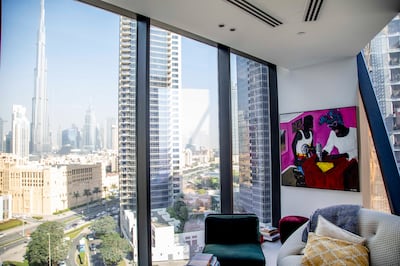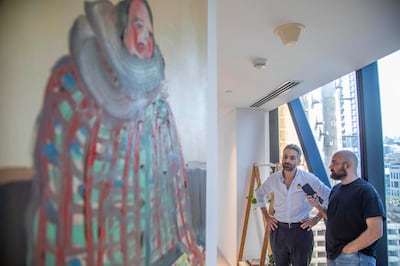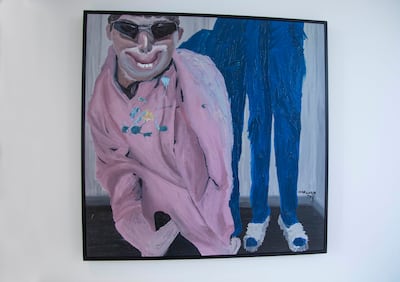Yves Hage’s two-bedroom apartment in Business Bay feels like a contemporary art gallery that a Lebanese pharmaceutical professional happens to live in.
Paintings hang across the space with thoughtful curation. Works too large to hang instead lean against the floor-to-ceiling windows. The storage room, meanwhile, is filled to the brim with crates that the paintings were shipped in. Hage even chose the apartment with his art collection in mind. The windowed walls look towards Burj Khalifa and taper at the end of the living room, providing ample natural light for the artworks.

Hage’s collection spans contemporary works by Arab and global artists. “I began collecting 10 years ago,” Hage, who has been living in Dubai since 2013, says. “I started to buy some Middle Eastern art when I was in Beirut. I then moved to global art. I still shift between both.”
As a collector, Hage says he is not so driven by market trends or even a specific curatorial vision. Rather, it is instinct and first impressions that determine whether an artwork is for him.
“It’s about the feeling you get when you stand in front of the artwork,” he says. “Whether your feeling matches the artist’s vision or not, it doesn’t matter. It’s only what you feel out of this artwork, what matters because you will wake up and see it every day.”
However, Hage considers the fact that tastes evolve, and if an artwork no longer resonates with him, there’s always the possibility of putting it up for sale. This was certainly true for some of the first works in Hage’s collection, which included the works of Sabhan Adam. Over time, Hage no longer felt moved by the figurative paintings, which sought to challenge concepts of beauty and ugliness, and he sold them off.
Hage acquired a few paintings by Adam when the market for the Syrian artist’s works had “collapsed”, and when he did eventually sell the works, the artist’s desirability among collectors had somewhat stagnated. Yet, buying art with the market in mind shouldn’t be a primary consideration for collectors anyway, Hage says, especially with contemporary works.
“It’s not like the old masters where you know the value of your money is stable,” he says. “When you go to contemporary works, there are peaks and valleys, it goes up and collapses. Sometimes you might be weak and follow the hype. It’s not necessarily the right thing. Instead, focus on what you love.”

Upon walking into his apartment, Hage’s penchant for contemporary works is immediately evident. A rather provocative work by US painter Grace Metzler is one of the most immediately noticeable pieces. The large painting shows a woman in military boots but otherwise naked, holding a small canvas over her head and painting. She has donned earphones, which are plugged into a synthesiser being played by a person with a vibrant oversized sweater and scarf, and haphazardly applied make-up. There is a dog sitting in the centre of the room. The woman is urinating as she paints.
Hage acquired the piece before the artist had finished it, and when she eventually did, Hage had second thoughts about buying it.
“She is a big name nowadays in New York, I love the craziness of the piece,” he says. “She is listening to the music on the wire, and painting at the same time. All her senses are engaged somehow. The painting has a weird story. When I decided to acquire it, she didn’t have blue hair and he didn’t have a scarf. A week later, it completely changed. Two weeks later, she changed it completely again, adding the scarf and the blue hair.”
Hage acquired the piece anyway, and now, reflecting on the acquisition and comparing it with photographs of how the work looked before the changes, the collector says he is happy that Metzler introduced those elements. As much as evolving tastes and research can detract from a collector’s appreciation of a piece, it can also augment it.

One of the most stirring and evocative works in Hage’s collection is also one of his most recent acquisitions. Farah Atassi’s Dutch Kitchen depicts a room with a tiled floor and walls. The sight is an uncomfortable one, replete with an inert drama. The overhead fan, hanging from the dark ceiling, is motionless. A wheelchair has toppled over. The tiles are stained, and the only colours on the otherwise monochromatic piece are streaks of navy and red, laid horizontally on a counter – they are presumably books.
“She titled this piece Dutch Kitchen, but again, it is about the feeling it generates in your head,” Hage says. “It can be a hospital that has been evacuated, or a destroyed bathroom. Despite [featuring chiefly] white and black, it has tremendous textures, layers, depth. I think the execution is just incredible. It’s fantastic.”
Other stunning works in Hage’s collection include two works by Polina Barskaya. The Ukraine-born artist, who lives and works in Brooklyn, is known for her confessional works, which depict herself and her domestic space through acrylic and wood. In one of the two works in Hage’s collection, Barskaya depicts herself sitting on a couch nursing her child late in the evening. Her eyes show an intensity that exhibits her sleepless state. In the other, she is sitting in bed, with a calm but groggy expression, as her husband, naked, examines himself in the mirror.

“When I see her art, it reminds me of two big masters, Alice Neel and Philip Pearlstein,” Hage says. “Look how she’s able to draw the faces. For me, the [Neel] painting is a mother at five in the morning; she hasn’t slept a minute; she is taking Prozac and still breastfeeding. She’s a very ‘painterly’ painter, and these days, there aren’t many of those left. There is a feeling of drama as she depicts her own life as far as her husband and baby.”
Hage’s inclination towards figurative pieces are as prominent when regarding his collection of Middle Eastern art. There are paintings by Omar Gabr that show the young Egyptian artist’s artistry in accentuating and exaggerating physical features that evoke emotions that range from bliss to anxiety, sometimes simultaneously.

Evelyn Ashamallah is also represented in the collection. The Egyptian artist is well known within collector and artist circles in the Middle East, even if she still hasn’t had her due exposure to the wider public, Hage says. The two artworks by Ashammallah within Hage’s collection are true to the artist’s whimsical and somewhat surreal approach, anthropomorphising buildings, celestial bodies and other, more amorphous figures.

By the counter of the open kitchen, four paintings by the Iranian artist Ehsan Arjmand are displayed. The works are made from acrylic on either copper or aluminium plates and feature human and animal figures. In one, a mother protects her child’s hearing from the barking of dog. A clown scowls at a cat. Lovers embrace with a large fish in the background, whereas in the fourth, a headless figure hangs from a fish hook. The pieces show Hage’s preference for figurative works that teeter on the edges of the surreal.
Hage says his collection was built on years of honing his own artistic sensibilities. He says it is key to follow art institutions, programmes and galleries that have “a track record of building artist’s careers”.

Collecting, Hage says, is a “never-ending” learning process that is gratifying in and of itself. The process involves research, meeting artists and other collectors, figuring out logistics and even the act of curating the works in a living space will add a novel dimension to the works.
However, when asked what advice he’d impart to collectors just starting out, he says: “Before buying anything, you must train your eyes.”
“It’s like going to the gym, you want to grow your muscles,” Hage says. “You need to train [a collector’s mindset]. You need to train your eyes in museums and exhibitions. I have also worked on myself and trained my eyes.” However, his primary insight goes back to his point of instinctual collecting, to go back to the pieces that have struck a particular chord. It’s all about the artworks “that you can’t stop thinking about”.
Updated: April 01, 2024, 2:48 PM
This post was originally published on this site be sure to check out more of their content







